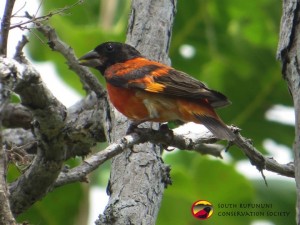
Update December 20, 2016
As 2016 comes to a close, the Red Siskin Initiative would like to wish you and your family a very warm season’s greetings. Please enjoy the photos and recent updates on all areas of the RSI conservation research and action in the attached newsletter. As always, we want to thank you for your continued support and interest in this important work! If you would like to make a contribution to Red Siskin conservation efforts, please visit our website (www.redsiskin.org
SCBI hosted a celebration of the Red Siskin Initiative at their headquarters in Front Royal Virginia on Friday September 23rd. It was a wonderful opportunity for the team to
share our progress and vision for Red Siskin conservation and biodiversity sustainability throughout the region. We added new friends and supporters and look forward to
adding more important connections in the coming months.
Congratulations to Jon Paul Rodríguez, IVIC, who co-founded Provita and the RSI on his recent election to chair of the IUCN Species Survival Commission! We know Jon Paul will provide excellent leadership for global conservation!
Red Siskin Initiative: Recovery and Protection of a Highly Endangered Bird
Although the RSI was originally founded to study, recover and protect the Red Siskin, our broader mission is to apply our expertise and organizational resources to the benefit of regional conservation of species and habitats. In 2016, the RSI received a William Belton Conservation Grant from the American Bird Conservancy (ABC) to search for the Tachira Antpitta (Grallaria chthonia) in remote cloud forest of western Venezuela as part of their Search for Lost Birds program. This “Lost” bird has not been reported since the type specimen was first described in 1955 by William Phelps Jr. and Alexander Wetmore, 6th Secretary of the Smithsonian Institution (Wetmore and Phelps 1955). Stay tuned for an expedition report.
Recent Update
The Red Siskin Initiative is getting remarkable press in 2016 including a feature in the largest newspaper in Guyana, an article in the June Atlantic Magazine and most recently featured in the most important newspaper in Venezuela! Check out the latter article here.
Status
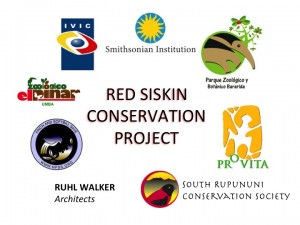 This project concerns conservation of the Red Siskin, Sporagra cucullata, an emblematic bird species in northern South America that is primarily threatened by wildlife trafficking for the pet trade. Classified as endangered by IUCN since 1952, the species is also listed in the US Endangered Species Act and CITES Appendix I. Red Siskins had been broadly distributed across northern Venezuela but today only a few isolated colonies remain, with a total population that may number only several hundred individuals. There was also a presumably natural population near Cúcuta, Colombia, but its present status is unknown. In Puerto Rico, there was an introduced population until it was eliminated around 1970. In Trinidad and the islands of Monos and Gasparee, the species was always rare, and has been extinct since 1960; doubts persist about whether these populations were natural or introduced. Historical reports from Cuba were probably of escaped cage birds, with no recent reports. Southeast Guyana presently harbors the largest known population, between a few hundred to a few thousand individuals, more than 950km from the closest known historical distribution in Venezuela. Preliminary molecular studies are consistent with a natural origin for this population. In 2003, Guyana joined all other countries where the Red Siskin has occurred in the wild by enacting legal protection.
This project concerns conservation of the Red Siskin, Sporagra cucullata, an emblematic bird species in northern South America that is primarily threatened by wildlife trafficking for the pet trade. Classified as endangered by IUCN since 1952, the species is also listed in the US Endangered Species Act and CITES Appendix I. Red Siskins had been broadly distributed across northern Venezuela but today only a few isolated colonies remain, with a total population that may number only several hundred individuals. There was also a presumably natural population near Cúcuta, Colombia, but its present status is unknown. In Puerto Rico, there was an introduced population until it was eliminated around 1970. In Trinidad and the islands of Monos and Gasparee, the species was always rare, and has been extinct since 1960; doubts persist about whether these populations were natural or introduced. Historical reports from Cuba were probably of escaped cage birds, with no recent reports. Southeast Guyana presently harbors the largest known population, between a few hundred to a few thousand individuals, more than 950km from the closest known historical distribution in Venezuela. Preliminary molecular studies are consistent with a natural origin for this population. In 2003, Guyana joined all other countries where the Red Siskin has occurred in the wild by enacting legal protection.
Ecology
Red Siskins use a variety of habitats in Venezuela, including tropical wet mountain forests, deciduous and spiny scrub forests-savanna ecotone in premontane and arid areas, and nearby disturbed areas. It appears to prefer open, relatively dry forests between 400 to 1400 m elevation and migrates altitudinally according to seasonal precipitation. In the Rupununi region of Guyana, Red Siskins occupy remarkably different habitat that is characterized by a mix of mountainous areas, rocky outcrops with forested areas and relatively open groves of trees, predominantly Curatella Americana, surrounded by grassland that may be flooded during the rainy season and hot and dry for the remainder of the year. In both countries, females have been observed to nest throughout the year, depending on habitat conditions, with 1-4 eggs per clutch.
Conservation Planning Synopsis
Venezuela
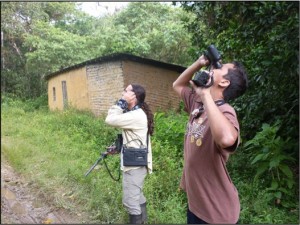 Conservation planning for Red Siskins in Venezuela involves ex situ and in situ approaches. Parque Zoológico y Botánico Bararida (PZBB) and el Pinar are two Venezuelan zoos in Barquisimeto and Caracas, respectively, that are establishing Red Siskin conservation breeding programs in coordination with a research population at the Smithsonian Conservation biology Institute (SCBI) in Front Royal, Virginia. The zoos will produce birds for augmentation of existing wild populations and reintroductions to unoccupied locations within the historic range. SCBI will support these programs by studying and optimizing husbandry, breeding techniques and management as well as adaptive transition to prepare birds for release (see ex situ population at SCBI below). In preparation for reintroduction, researchers from Instituto Venezolano de Investigaciones Cientificas (IVIC) have been studying Red Siskin ecology and behavior in the field and assessing potential release sites. Some release sites will be shade coffee and possibly cacao farms certified as “Bird Friendly” by the Smithsonian Migratory Bird Center (SMBC) that will be managed to meet key habitat requirements for Red Siskins. We will also work with farm managers to establish enhanced monitoring and security to deter trapping. Together, SMBC, IVIC and Provita, the only Venezuelan NGO with a history of successful avian reintroductions, are laying the foundation for Red Siskin reintroduction.
Conservation planning for Red Siskins in Venezuela involves ex situ and in situ approaches. Parque Zoológico y Botánico Bararida (PZBB) and el Pinar are two Venezuelan zoos in Barquisimeto and Caracas, respectively, that are establishing Red Siskin conservation breeding programs in coordination with a research population at the Smithsonian Conservation biology Institute (SCBI) in Front Royal, Virginia. The zoos will produce birds for augmentation of existing wild populations and reintroductions to unoccupied locations within the historic range. SCBI will support these programs by studying and optimizing husbandry, breeding techniques and management as well as adaptive transition to prepare birds for release (see ex situ population at SCBI below). In preparation for reintroduction, researchers from Instituto Venezolano de Investigaciones Cientificas (IVIC) have been studying Red Siskin ecology and behavior in the field and assessing potential release sites. Some release sites will be shade coffee and possibly cacao farms certified as “Bird Friendly” by the Smithsonian Migratory Bird Center (SMBC) that will be managed to meet key habitat requirements for Red Siskins. We will also work with farm managers to establish enhanced monitoring and security to deter trapping. Together, SMBC, IVIC and Provita, the only Venezuelan NGO with a history of successful avian reintroductions, are laying the foundation for Red Siskin reintroduction.
Establishing a research population at SCBI is a leading priority. The main purpose of this population is to conduct research and develop protocols for breeding and release that will inform facility design and operations of breeding programs at PZBB and el Pinar. Some potential questions/tasks that can be addressed with a captive research population include:
1. Enclosure/cage size; e.g. what is ideal cage size to optimize breeding and produce birds fit for release?
2. What is the optimal age for reproduction without losing genetic diversity in the population?
3. Incorporating advanced molecular tools for breeding management (see genetic threats below)
4. Develop basic caretaking protocols.
5. Develop breeding and chick rearing protocols.
6. Nutrition/diet
- Develop protocols for maintenance and breeding
- Determine receptivity of birds to novel food items (important for released bird survivability in the wild).
- Determine maximum reproduction without affecting the health of the breeders.
7.Health management
- Develop medical care protocols
- Determine known common health concerns from private breeders
- Vaccinations (West Nile)
- Develop anesthesia protocols
- Investigate parasitology (Atoxoplasmosis, cryptosporidia, coccidia, pseudomonas, etc.)
8. Document growth and developmental stages
- Take daily pictures of chicks to develop an aging chart
- Weights
- Morphometrics
- Physical changes over time (eyes open, feather eruption, color changes, etc.)
9. Investigate the best means of tracking released birds (radio transmitters, PIT tags, bands)
- Determine ability to use harnesses
10. Determine social dynamics
- How should animals be housed/kept (breeding, non-breeding adults and juveniles, different sexes, different ages, reproductively senescent)?
- Best density of birds for optimal reproduction
- Mate choice determination
- Learning period for juveniles (resource location, vocalizations, breeding behavior)
Guyana
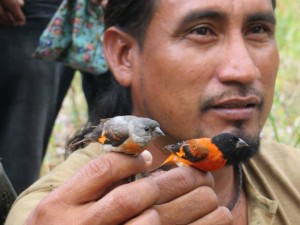
A different strategy is being employed for conservation of the Red Siskin in Guyana, one that is centered around community stewardship. With the help of capacity building efforts by the SI, local Guyanese formed the South Rupununi Conservation Society (SRCS; facebook page) to manage conservation of the Red Siskin and other species as well as to organize citizen science programs, train conservation leaders or “rangers” within the community, promote conservation-based economic opportunities, and provide environmental education to villages including formal curriculum for primary schools that fosters appreciation of their natural heritage. The central aim is to combine these priorities to organize an effective community based monitoring program that is closely coordinated with Guyana EPA law enforcement. Red Siskins in Guyana are endemic to an approximately 70 X 100 mile are and there is no evidence of any threats to this population prior to its recent discovery in 2000 suggesting it has been historically stable at current size. Thus, monitoring and protection may be sufficient to sustain this population without ex situ input.
Threats
Wildlife Trade
The main threat to the Red Siskin is capture for the pet trade, which has been active since at least the 19th century. The species has been traded for feathers, hat decorations and as pets, but mainly for avicultural production of red canaries through hybridization, described in the book “The Red Canary: The Story of the First Genetically Engineered Animal” (Birkhead, 2003). Although imports into Europe and Australia have decreased since bans on bird imports were implemented to reduce disease transmission,total international demand for Red Siskins, both legal and illegal, is still apparently large. In Venezuela, traffic is not open and in large numbers as it is for other species, but is more furtive, with much conducted online. In Guyana, efforts to raise awareness about Red Siskin conservation since its recent discovery have also had the counterproductive effect of advertising its commercial value and creating a new market for this species. This may be exacerbated as indigenous people living near Red Siskin habitat are transitioning from subsistence to cash economy, putting increased pressure on natural resources as a source for income. Active and legal trade of other bird species in Guyana, some sharing the same habitat as Red Siskins, also increases the risk of capture and sale of this species.
Policy and law enforcement has a critical role to play in controlling the illegal supply of protected wildlife; however policing and penalties related to wildlife trade are relatively weak in both countries. Completion of breeding and rescue facilities in Venezuela will provide important leverage to advocate for greater enforcement and confiscations, especially in Lara state where the Red Siskin is the state bird and the legislature has legally committed PZBB to conservation of this species. In Guyana, the recently passed Wildlife Management and Conservation (WMC) Regulations (2013) made under the Environmental Protection Act (1996) imposes heavier fines for illegal trafficking and establishes creation of ‘conservation sites’ to protect habitats and species. SRCS and EPA are also cooperating to establish a systematic procedure for monitoring, reporting and tracking trafficking activity, and EPA will soon have its own enforcement agents. Internationally, the project is cooperating with other programs that are conducting research into trafficking networks and working to interrupt them on a regional and global scale.
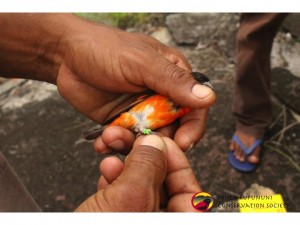
Although law enforcement is essential to combat trafficking, alone is not enough. Complementary approaches that raise awareness of the problem and diminish consumer demand for wildlife are also needed. To meet this need, the project is expanding existing conservation education efforts aimed at priority audiences including cage bird hobbyists and pet consumers (National Finch and Softbill Society, (NFSS), indigenous peoples in Guyana (SRCS), policy makers and elected officials (Guyana EPA, PZBB, el Pinar, Provita), as well as students and the general public (SI, PZBB, el Pinar, Provita). Captive breeding of Red Siskins is also under consideration as an alternative way to satisfy commercial demand; however, at present there are no examples from other bird species suggesting that commercial production under current conditions would improve the status of wild populations.
Habitat
There is much former habitat in Venezuela that remains intact and ecologically should be able to sustain large populations of Red Siskins. However, the increasing loss of dry forests to urban development in the northern half of the country is a growing concern and cooperation with other organizations working to preserve these areas should be pursued. Similarly, there is no immediate risk to Red Siskin habitat in Guyana but the recent arrival in the southern Rupununi of large-scale, foreign-owned agricultural developments warrants efforts to protect vital habitat, such as advocating for creation of a WMC conservation site (see above).
Another habitat concern in the Rupununi is fire, which is used extensively to manage lands for grazing. Properly controlled burning can benefit wildlife because it promotes availability of nutritious food; however, fire also poses a threat to nesting sites and intensive burning coinciding with a drought can have disastrous results. Strategies for fire management to avoid habitat destruction warrant further study. Conversely, severe flooding during the rainy season is a risk because food sources can become limited. Supplemental feeding could be an effective strategy during severe or prolonged periods of flooding.
Genetic Threats
Three priority genetic concerns for this project include low genetic diversity, inbreeding and hybridization. Genetic diversity is important for ecological resiliency in response to habitat changes, disease and many other factors. The total population in Venezuela may include only hundreds of birds since the 1980’s or longer. This small number of individuals over an extended period of time raises the risk of an “extinction vortex” that occurs when a species drops below a certain threshold of genetic diversity, making it impossible to recover a sustainable population. To assess this risk and to provide requisite data for a population viability analysis (PVA), current genetic research aims to assess the genetic diversity among contemporary populations of Red Siskins and compare to historic levels using genetic samples collected recently from wild caught birds and from early 20th century museum specimens, respectively. Also, field ecologists from SMBC are partnering to develop protocols to generate best estimates of population size and density and to collect other important demographic data. A preliminary PVA will be conducted to identify important data gaps that will help in developing data collection strategies. With the addition of new data, the PVA can be updated continually and refined, which ultimately will enable well-informed decisions that are critical to successful ex situ breeding and planning for reintroduction.
Hybridization is a special concern for this species because aviculturalists have for many decades been cross breeding Red Siskins with closely related species to make red canaries and other cage bird varieties, some of which may have been released or escaped into natural populations and possibly reproduced with wild birds. Also, natural hybridization may be prevalent among wild Red Siskins due to the rarity of con-specific mates. To preserve the genetic integrity of the Red Siskin, genomic screening will be performed to detect cryptic hybrids and exclude them from ex situ breeding. Creation of this genomic assay is currently in progress at the NMNH, involving whole genome sequencing of Red Siskins and other species with which they are known to hybridize.
Inbreeding can cause a wide variety of deleterious consequences that can fatally undermine population viability. To address this concern, genetic studies will assess the inbreeding risk within wild populations in each country and breeding managers will apply careful record keeping and highly sensitive molecular analysis of relatedness based on large numbers of genomic markers to limit inbreeding in captive breeding programs.
Disease
Disease is a major potential threat to any wild or captive population. Presently, there are no known extraordinary disease threats to wild populations in either Venezuela or Guyana. However, to mitigate the risk, veterinary management of all three ex situ populations will follow best practices based on experience and close consultation with other relevant programs. The populations at PZBB and el Pinar will also serve as crucial reciprocal insurance for each other.
Red Siskin Recovery Workshops
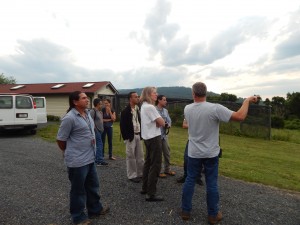
In July 2014, the Red Siskin Recovery Project held a conservation planning workshop at the Smithsonian Mason School of Conservation (SMSC) Conference Center on the SCBI campus in Front Royal Virginia, which was featured in the October IUCN newsletter. This meeting, funded by the Smithsonian Grand Challenges Consortium, brought together representatives of all partner organizations and external experts to discuss key project components, develop strategies and prioritize activity (see the Workshop Agenda on the Braun Lab Website: Red Siskin Project). In November 2014, project members from the SI will visit partners in Venezuela for a reciprocal workshop that focuses on advancing their captive breeding programs, establishing the shade coffee/cacao certification program, and implementing survey protocols to estimate population size and density. It was also decided at the SMSC workshop that the project would begin planning for a Population Viability Analysis workshop in the near future in coordination with the Conservation Breeding Specialist Group.
